Most vegetable gardens are filled with annual vegetables that are started from seed or seedlings each and every year. After harvest, the soil is turned, and the whole process begins again the next year. Why not add a few perennial crops to the mix? Planting perennial vegetables means you can enjoy their yield year after year without replanting, and because perennials often produce at different times than annuals, having both in the garden extends the harvest.
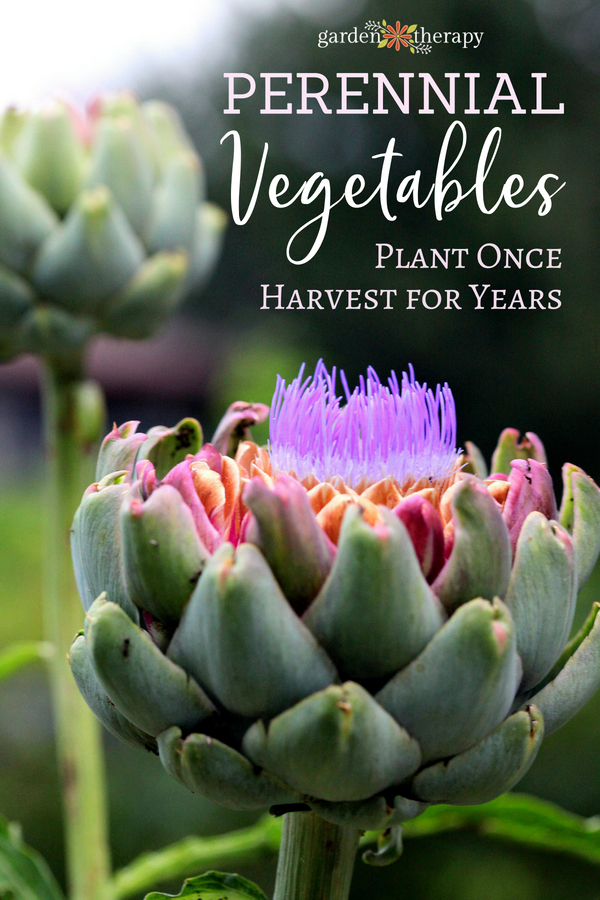
When it comes to making a more resilient, self-sufficient garden, the fewer annuals, the better. Now, don’t get me wrong, I love to plant my lettuce and other veggie staples or my container gardens full of ornamental flowers and bulbs. But a good chunk of my garden was perennials.
I’m in the midst of designing my new garden, and I know that I’m going in with the mindset of creating an urban food forest. Food forests are a selection of carefully curated plants that seek to mimic a natural forest ecosystem to produce as much food and materials as possible.
Ideally, everything in my garden will be multi-purpose. All of my ornamentals will be medicinal or culinary (maybe with a few exceptions. I love my bulbs!).
The vegetable garden is notorious for taking the most amount of effort, resources, and space in a lot of gardens. But when you combine practices like food forests, succession planting, and perennial vegetables, your garden becomes a little powerhouse with very little effort on your part.
Get inspired with this list of perennial vegetables!
- 24 Perennial Vegetables
- 1. Artichoke
- 2. Asparagus
- 3. Bamboo Shoots
- 4. Chicory
- 5. Chinese Artichoke
- 6. Dahlias
- 7. Egyptian Walking Onion
- 8. Good King Henry
- 9. Horseradish
- 10. Lovage
- 11. Nettle
- 12. Oca
- 13. Ostrich Fern Fiddleheads
- 14. Perennial Kale
- 15. Potatoes
- 16. Purple Sprouting Broccoli
- 17. Radicchio
- 18. Rhubarb
- 19. Scarlet Runner Bean
- 20. Skirret
- 21. Sorrel
- 22. Sunchokes
- 23. Watercress
- 24. Wild Leeks
- Perennial Berries
- Perennial Fruit and Nut Trees
- Perennial Herbs
- Frequently Asked Questions About Perennial Vegetables
- More Ideas for the Vegetable Garden
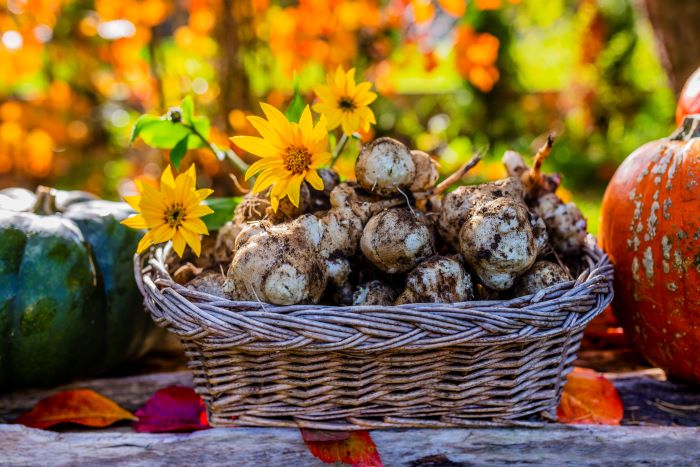
24 Perennial Vegetables
These are some of the most tried and true perennial vegetables you can find on the market.
While some may not be as easy to source as annual vegetables, they’re well worth the effort since they’ll come back year after year.
1. Artichoke
Cynara scolymus
Zones 7-11
Artichokes are beautiful and decorative in the garden and a must-have for the perennial vegetable garden. Plus, they produce for up to five years!
Give them plenty of space when planting them because they can get very large when they mature – up to four feet tall and four feet wide.
Artichokes like full sun and fertile, well-drained soil. Growing them as perennials requires good quality soil with drainage to keep the roots from rotting, especially during the winter.
Artichokes need lots of moisture for the buds to develop. Make sure to water them frequently in the absence of rainfall.
Artichokes take two years to flower. Harvest artichokes when they feel firm and have a diameter of at least three inches. Store the harvest in the fridge and eat them within two weeks.
Artichokes you do not harvest will open and produce stunning purple flowers. To overwinter artichokes, cut back the plants and cover them with thick mulch.

2. Asparagus
Asparagus officinalis
Zones 3-10
Asparagus crowns need a few years to become productive after initial planting, but it is worth the wait as asparagus will keep coming back for up to thirty years.
Nothing tastes quite like fresh asparagus from the garden. You don’t even need to cook it; you can snap it, eat it, and revel in its deliciousness.
Asparagus can be tricky to start, so you want to give them the best conditions possible. Plant them somewhere with 8 hours of full sun in well-draining soil.
Weed frequently and give asparagus its own bed without any other vegetables growing in it because it gets choked by other plants easily.
Don’t harvest asparagus for the first three years. Harvest spears by snapping them off at the bottom when they reach five to seven inches tall.
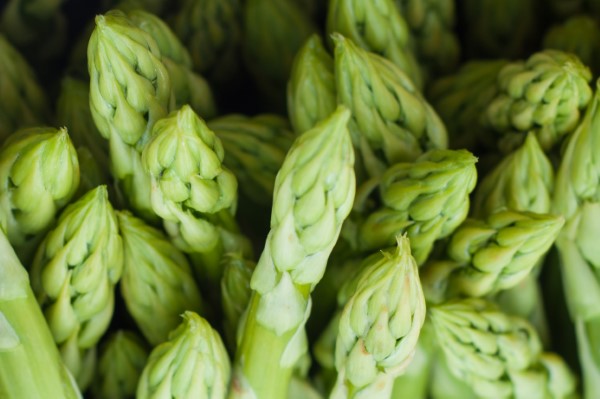
3. Bamboo Shoots
Popular in many Asian dishes and soups, bamboo shoots come from edible bamboo species such as Bambusa vulgaris and Phyllostachys edulis. The genus Phyllostachys is generally a good choice, as they’re cold-hardy and produce plenty of good shoots for eating.
It’s not difficult to grow bamboo. They like lots of moisture and a sunny location. With fertile soil, no extra fertilizer is needed.
Bamboo shoots will emerge from the ground, almost like asparagus. They’re tender and tend to grow in the spring. They should be cut and harvested right when they emerge from the ground and are less than 6 inches tall.
The younger the shoot, the better it will taste! Detach the shoots from the root system with sharp pruners. Peel the outer leaves of the shoot until you get to the soft white, edible interior.
Bamboo can be infamous for getting out of control. You must actively control the bamboo or grow it in containers to ensure it doesn’t choke out other plants. But, if you keep harvesting the shoots as they’re meant to be eaten, you’ll do just fine.
4. Chicory
Cichorium intybus
Zones 3-10
Chicory root is often used to produce the inulin you find at the drug store, a fibre supplement that works as a prebiotic. AKA it’s amazing for gut health. Chicory comes from the dandelion family and also has a very long taproot. It has a violet-blue flower that’s also edible.
Besides being a great source of fibre, people use chicory as a coffee substitute. To do so, the root is baked and then ground into a powder used to make the drink.
Chicory is self-seeding and is the kind of plant that will grow between cracks in the sidewalk—you don’t have to worry much about the growing conditions for the plant.
You can plant the seeds in early spring, sowing them just 1/4 inch deep. Once the plants emerge, thin the seedlings about 1 ft apart.
Since you’ll eat the plant’s root, you’ll want the soil to be loose for easier harvesting. Mix in sand if you have clay or hard soil.
5. Chinese Artichoke
Stachys affinis
Zones 4-8
These may be a little harder to find, but if you do, they’re a super easy perennial vegetable to grow. From the mint family, they have a similar appearance but different taste. The part you enjoy eating is the very crisp tubers with a slight artichoke flavour.
They’ve grown popular in France, where they’re called crosne. The small tubers have a short shelf life, so they often have a high price tag, which is why it’s a great idea to grow them yourself!
Even with the rarity and price behind them, they’re not a difficult perennial vegetable to grow. They like full sun and well-draining soil that’s kept moist.
Chinese artichoke can become an invasive species, so be generous in your harvesting to keep them under control. The tubers take 5-7 months to reach maturity, often harvested in the fall once the plant is dormant.
6. Dahlias
Dahlia spp.
Zones 8-10
What if your perennial vegetables doubled up as gorgeous ornamental flowers?! Most people don’t know that you can actually eat dahlia tubers. The tubers are cooked like a potato, though they’re best peeled since the skin has a bitter taste.
Make sure only to eat tubers that haven’t been treated with chemicals. They’re best eaten when you’ve grown them from seed yourself or have come from a trusted, divided plant.
I won’t blame you if you want to enjoy these plants solely for their stunning bulbs and not for their edible purposes.
You can grow dahlias from seed, but they’re much easier to grow from a tuber. The tubers should be planted no more than two inches deep. As the plant gets bigger, the tubers multiply and allow you to harvest them.
Check out my full guide on growing dahlias for more growing trips.
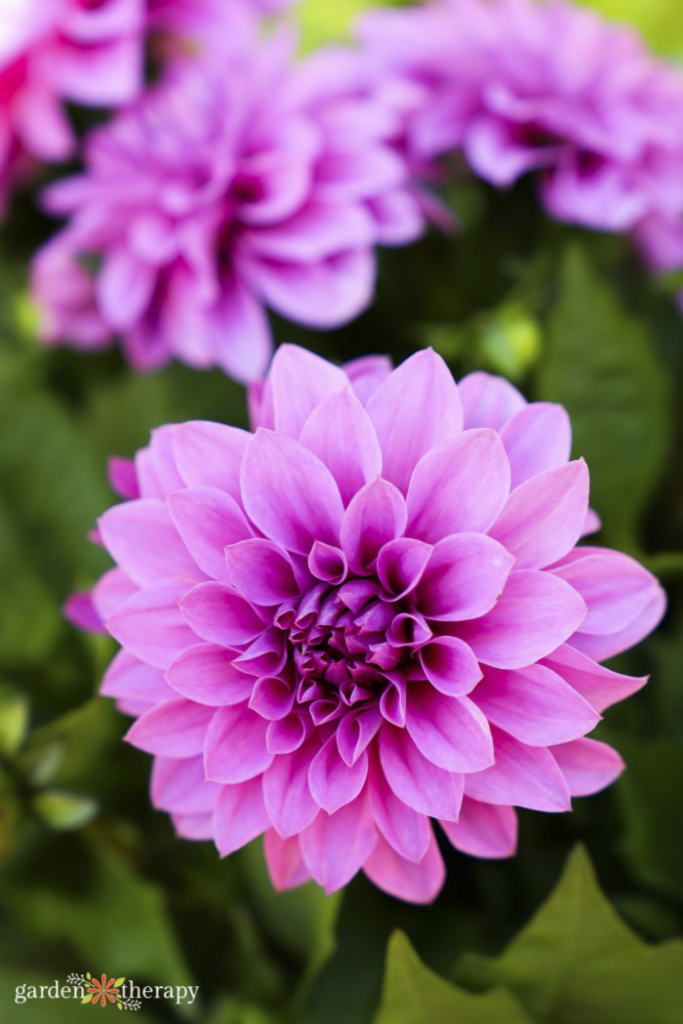
7. Egyptian Walking Onion
Allium proliferum
Zones 3-10
A member of the allium family, the Egyptian walking onion has stems in the spring that you can eat like scallions.
As they grow, they have tiny bulbs on top that slowly cause the plant to double over with the weight, effectively planting themselves in the ground—or walking, if you will. They multiple quick, and you can easily have a garden full of these onions in a few years.
You can eat the bulbs that grow on the top of the flower, dig up the bulbs from the ground, or even eat the stem. There are lots of edible options for this one!
If you’re introducing an Egyptian walking onion to your garden, it’s best to plant the bulbs in the fall. Give them a good soak, and let them sit overwinter. Come spring, you’ll have a new onion plant that will start walking and plant itself.
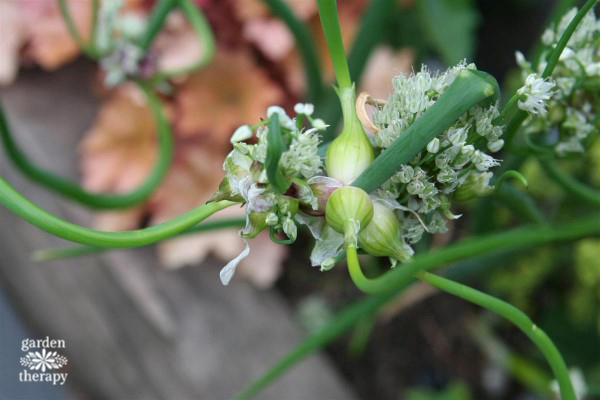
8. Good King Henry
Chenopodium bonus-henricus
Zones 3-9
Most people use Good King Henry like they would with spinach. The leaves can be cooked or eaten raw, though they are bitter when left raw. The thin shoots that emerge in spring can also be eaten like you would asparagus.
In early spring, you can also eat the thick shoots. Yes, another plant that is cut and grows like asparagus! The flower buds that emerge in the spring and summer can also be eaten.
You can grow Good King Henry from seed, but they take a little to germinate. Cold stratification in the refrigerator or a container outdoors can help.
Once planted in the garden, give them three years to establish themselves before you begin harvesting from the plant.
9. Horseradish
Armoracia rusticana
Zones 4-8
I’m sure you’re familiar with the kick of horseradish sauce for dipping and alongside some of your favourite dinners. It’s a member of the mustard family and has a similar spice.
Horseradish has a white taproot that grows in the ground, much like a carrot. When you grow them in the garden, they can get very spicy. Depending on your taste buds, this can be good or bad.
Horseradish doesn’t mind full sun to partial shade, though it should get some protection from prolonged heat. It needs 3-5 feet of space to be grown as a perennial.
Horseradish can become quite invasive, so you can eat as many of the roots and leaves as you like, and it will quickly grow back. The roots are ready to harvest by the fall.
10. Lovage
Levisticum officinale
Zones
Although lovage looks more like celery, it is a member of the carrot family. Every part of this plant can be eaten.
The leaves make a tasty herb (try it in place of parsley), the root can be cooked and eaten as a vegetable, and you can use the stems as you would celery.
Just a little lovage goes a long way; it’s both flavourful and prolific. You will only need to plant one in your garden.
You can grow lovage from seed. Direct sow them by scattering the seeds on top of the soil after the risk of frost has passed or starting them indoors 6-8 weeks before the last frost date.
Plant lovage in partial sun to full sun in well-draining, rich soil. Keep the soil moist, as the leaves can develop a bitter taste if the plant dries out.
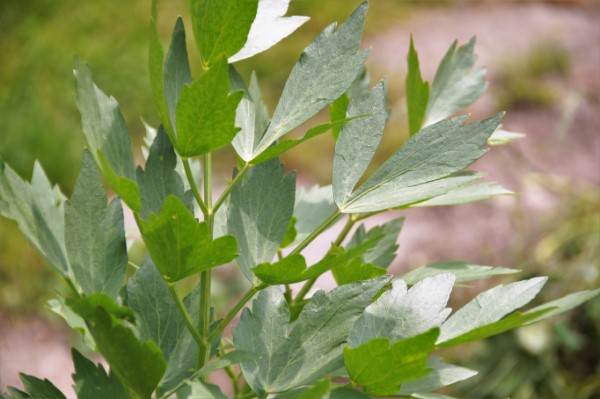
11. Nettle
Urtica dioica
Zones 4-10
For many, nettle is a weed and plant you might want to avoid due to its sting. But it’s actually a very nutritious plant that has a great, mild flavour when you harvest it young. It is one of the highest sources of minerals in edible plants and is a secret super green you won’t find at the grocery store.
So let’s grow it ourselves, shall we?
Nettle works as a soil fixer, so it can grow in just about any soil. You can easily grow it from seed, planting it in spring. Nettle ideally likes moist, shady places.
If you’re worried about harvesting and eating the nettle, the sting disappears once the plant has wilted. I have a full herbal guide on why nettle is so amazing to eat and how to harvest it.
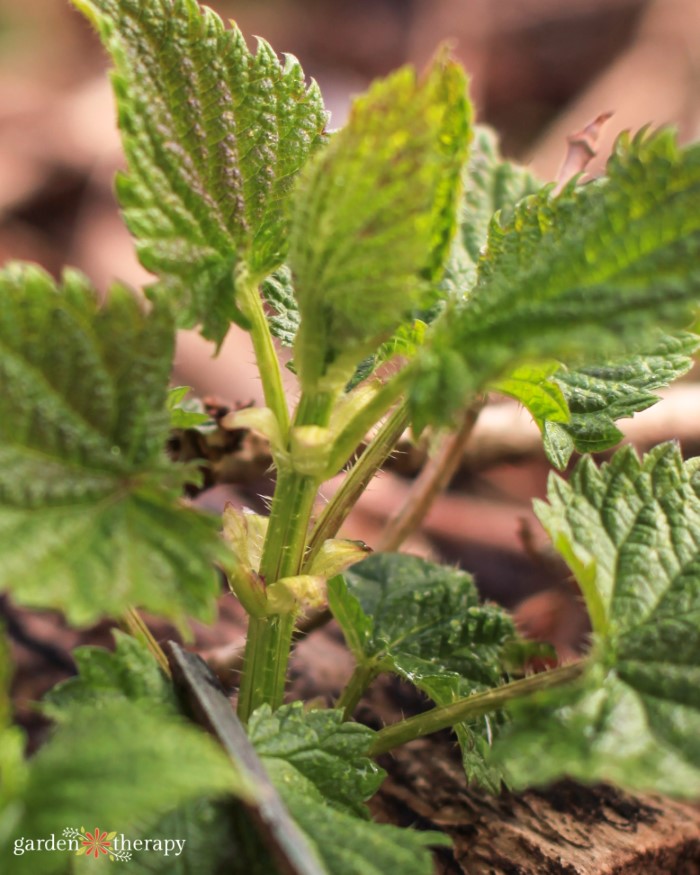
12. Oca
Oxalis tuberosa
Zones 9-10
I featured this vegetable in my post about great plants for climate change, as this is a perennial vegetable not well known in North America. However, it grows exceptionally well in the Pacific Northwest.
Native to South America, the tubers are very popular in the Andean region and are used like potatoes. When raw, they’ve got a crunch, and when boiled, they become super starchy.
You can grow Oca from seed or tubers. If grown from seed, you must start them indoors 6-8 weeks before the last frost as they need a long growing period. Growing from the tuber is a good way to grow them, as you can choose the large, strong tubers to reproduce.
Plant the Oca tubers after the last frost. They’ll grow in the spring and fall, slowing down in the summer heat. You can harvest them in the late fall once the plant springs back and begins to die back for the winter.
13. Ostrich Fern Fiddleheads
Matteuccia struthiopteris
Zones 2-7
When it’s fiddlehead season, you can’t escape it on Instagram. People love to go out and forage for these young and tender shoots in the spring. First things first, make sure you have the right type of fern when eating! Ostrich ferns are the ones most grown for edible purposes.
Once cooked, the fiddleheads are crisp and slightly nutty in flavour.
They look like a tight spiral coil and should be harvested when a few inches tall. They emerge in spring after the threat of frost has passed. The season for harvesting is short, typically only a couple of weeks.
Ostrich ferns like partial to full shade and moist soil. They should never be dried out, as they grow in moist and humid places.
Harvest only from plants with at least four fiddleheads; take no more than half of the fiddleheads available. This gives the plant enough leaves to gather energy for the growing season.
14. Perennial Kale
Brassica oleracea var ramosa
Zones 6-9
Perennial kale also goes by the name of tree kale or tree collards. If you love kale, this perennial edition has purplish leaves that can be used in salads and cooking.
Growing these plants from cuttings purchased at the garden centre rather than seeds is typically best. You can continue your own supply by taking cuttings from the outer stems. The plant likes full sun but will tolerate partial shade.
Perennial kale gets quite big, up to 8 ft. tall, so take this into consideration when planting. You can add in a trellis to help support the plant when it gets this big. The plant produces year-round for about five years, so you’ll have quite a supply of greens.
15. Potatoes
Solanum tuberosum
Zones 8-12 (as perennials)
If you do it right and live in a warm climate, your trusty, hardy potato can be a perennial vegetable. Often, they’ll grow back if you don’t harvest them, but that’s not always the case.
Now, you can purchase specifically perennial potatoes from a US breeder, such as ‘Purple Ease’.
Otherwise, most potatoes die when the ground freezes. Or, some might enter a period of dormancy. You might forget (wink wink) about a potato or two and be pleasantly surprised when a new plant forms without lifting a thumb.
16. Purple Sprouting Broccoli
Brassica oleracea var. italica
Zones 6-9
Purple sprouting broccoli is a perennial vegetable in mild climates but can do well in colder climates if it gets lots of sun and is planted in fertile, well-draining soil.
The tops look similar to broccoli florets but are purple in colour and aren’t quite as big. They are ready for harvest at the end of summer through to the end of fall.
To grow purple sprouting broccoli, start them as seeds early on indoors to give them plenty of time since they’re slow growers. For the plant to succeed as a perennial, you may need to give them some frost protection and a layer of mulch in the winter.
17. Radicchio
Cichorium intybus var. foliosum
Zones 8-10
You’ve definitely seen Radicchio at the grocery store before! I love its bright purple, burgundy colour. Due to its shape and colour, it’s often mistaken for red cabbage. But they do have a very different taste and have much smaller heads.
A variety of chicory, radicchio has a pretty bitter taste that gets much sweeter once cooked. You can grow them from seed, direct sowing them as soon as the ground can be worked. You can succession plant them as well in the first season (or as an annual) in mid-summer.
Harvest the leaves once they are large enough to eat. By early fall, cut off all the leaves above the crown. The new growth will result in the tiny, cabbage-like head you would find at the grocery store.
18. Rhubarb
Rheum rhabarbarum
Zones 3-8
Plant rhubarb in your garden and you will be rewarded with a ton of scrumptious pies, muffins, compotes, and crumbles (or how about delicious rhubarb sorbet?).
Rhubarb requires almost no attention once it’s planted and will come back year after year. This makes it one of the most popular and well-known perennial vegetables. Removing the flowers as they appear will produce more edible stems, so be vigilant and pluck the blossoms.
To promote growth, do not pick all of the stalks at once. Harvest up to one-third of the plant at a time by twisting and snapping the stems off at their base.
For more growth tips on rhubarb, check out my full rhubarb growing guide.
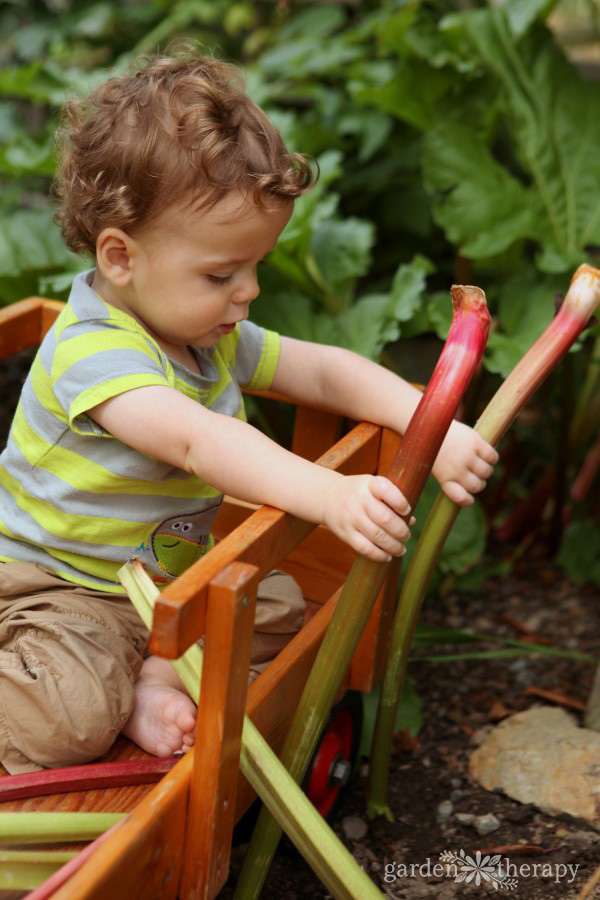
19. Scarlet Runner Bean
Phaseolus coccineus
Zones 7-11
In those lucky places with no frost, you can anticipate that your scarlet runner beans will return each year. Most of us grow them as annuals without realizing that they can be a short-lived perennial in the right warm climate. The same plant can return for up to 6 years.
In the summer, they have beautiful red flowers, doubling up as an ornamental. The flowers and leaves are edible, as well as the large green or purple beans. You can eat them fresh or dry them for soups in the winter.
Plant the seeds in an area with lots of sun, well-draining soil, and away from onions (they don’t like each other). When planted as annuals, wait until the threat of frost has passed.
20. Skirret
Sium sisarum
Zones 5-9
If you like carrots, you’ll like skirret. This European favourite has roots that taste similar to carrots with a distinct sweetness and are starchy, like potatoes. But unlike carrots, it only needs to be boiled or fried for a few minutes to be fully cooked.
Skirret grows in clumps, so it’s easy to produce more of the plant by dividing plants. Either find an existing clump to divide and plant or grow it from seed.
Plant it in full sun and fertile soil. Otherwise, the roots will be thin and not worth harvesting.
In the fall, you can harvest the clumped crowns and plant some of the divided crowns back in for the following year.
21. Sorrel
Rumex acetosa
Zones 4-9
Many people mistake sorrel for clover, though it has much larger leaves. Call it a herb or call it a perennial vegetable—it’s edible and easy to grow.
Three types of sorrel can be grown for edible reasons:
- Garden sorrel, Rumex acetosa
- French sorrel, Rumex scutatus
- Red-veined sorrel, Rumex sanguineus
Garden sorrel has a slight citrus flavour, and it works well added raw to salads or stewed up in a soup.
You can grow garden sorrel by seed or by dividing an existing clump in the summer (ask a neighbour!). They like full sun to partial shade and well-draining soil.
The plant self-seeds and can be invasive, so trim any flowers to keep them under control. Unless you want more sorrel!
22. Sunchokes
Helianthus tuberosus
Zones 3-8
Sunchokes, also known as Jerusalem artichokes, have an edible tuber that tastes like a water chestnut crossed with an artichoke.
They grow five to ten feet tall and, while a wonderful vegetable to have on hand, they can be invasive—make sure to give sunchokes their own bed, or they will take over the whole garden.
As far as perennial vegetables go, these guys are pretty hands-off. They’ll keep on reproducing and multiplying all on their own. Just make sure to leave behind some of the big ones so they come back the following spring.
Remove flowers as they develop to promote tuber production. Tubers keep up to 5 months stored in a moist, cool place.
Just a word of caution! Eat too many sunchokes at once, and you might get a stomach ache. When eaten raw, they can give you lots of gas and bloating.
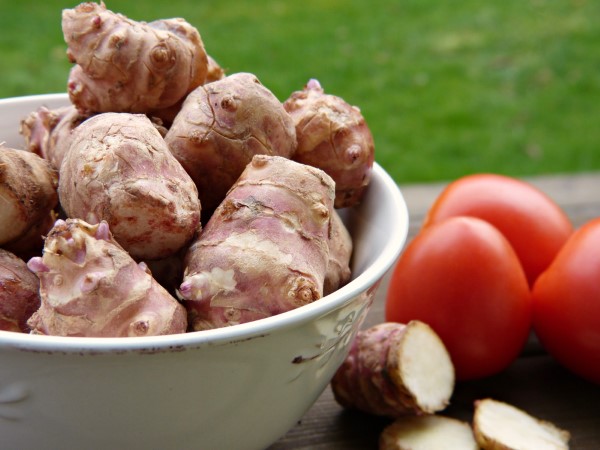
23. Watercress
Nasturtium officinale
Zones 2-10
Many different climates can grow watercress, making it an easy addition to the perennial vegetable garden. From the brassica family, this green loves a wet climate as they’re semi-aquatic. You can actually grow them in containers that stay constantly moist or in flowing water.
If you have a corner of your garden that lacks good drainage, watercress may be the solution for you. Barely cover the seeds when planting. You can plant them nearly any time of the year, even in pans of water.
The leaves have a peppery taste, like mustard. Once the plant flowers (small and white), the leaves become bitter, so be warned!
24. Wild Leeks
Allium tricoccum
Zones 3-7
Also known as ramps, wild leeks are perfect for foragers in North America. Ideal for woodland gardens, they grow in dappled shade and often spread through little bullets.
They may look like a regular leek but have a taste similar to garlic. You can eat the little white bulbs, but the real reason to grow them is for their leaves. You can use them like green onions or as sauteed greens.
If you eat the bulbs, you might lose the perennial vegetable altogether! Wild leeks take some time to get established. For this same reason, they’re best to grow from transplants or bulbs as the seeds take a long time to germinate and then reach maturity.
Perennial Berries
Don’t just stop at the perennial vegetables. A big part of growing food also comes from the trees and shrubs you plant. Here are some perennial berries that you can expect to produce every year with little input from you.
- Blueberry
- Strawberry
- Raspberry
- Blackberry
- Elderberry
- Cranberry
- Gooseberry
- Saskatoon berry
- Ground cherries
- Blackcurrant
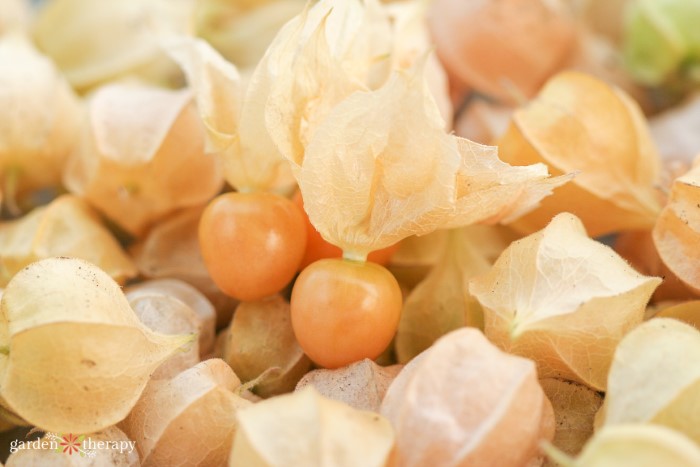
Perennial Fruit and Nut Trees
Flowering in the spring, fruit and nut trees are one of the best ways to support pollinators early in the season. Then, you get to enjoy the literal fruits of their labour when all the fruit and nuts come to maturity.
- Apricot
- Cherry
- Apple
- Peach
- Pear
- Plum
- Kiwi
- Mulberry
- Quince
- Grapes
- Lemon
- Fig
- Walnut
- Chestnut
- Hazelnut
- Pecan
- Almond

Perennial Herbs
Yes, many herbs are perennial! You can check out this list to determine which herbs are okay to grow in your zone, but here are some favourite herbs that grow as perennials in most climates.
- Rosemary
- Lemon balm
- Lavender
- Sage
- Chives
- Mint
- Oregano
- Tarragon
- Thyme
- St. John’s Wort
- Valerian

Frequently Asked Questions About Perennial Vegetables
So many of the perennial vegetables on this list are considered greens, like nettles, perennial kale, watercress, sorrel, and Good King Henry, among many others.
No, tomatoes are not perennials; the plants will not come from the same seed the following year. However, if you let a few of your tomatoes drop to the ground, you might have some new tomatoes seed themselves.
A perennial plant lives for more than two years. They may die back in the winter but come back the following spring from the same roots, tuber, or bulb. Meanwhile, an annual will germinate, flower, fruit, and die all in one season.
So many more plants could be added to this list of perennial vegetables and edible plants. Just remember to think outside of the grocery store. See what’s available at farmer’s markets, international grocery stores, and even what your neighbour grows.
There’s a whole world of edible perennial plants out there!




Great list, Stephanie! It’s too bad there are not that many perennial vegetables, as they are a lot less work. I did have some luck this year in overwintering two of my eggplants in the greenhouse and they are blooming again. Peppers are also supposedly perennial if you can keep them warm enough. Mine didn’t make it over the winter so I’ll have to do some more research on what is required to keep them for another year.
The only perennial vegetable we are growing is asparagus and they are recovering from having been moved last spring when I built my new raised beds. We do have some spinach growing in the same bed, so I’m not sure how that affects the asparagus. Hate to see the whole bed sitting empty once the asparagus is done.
I heard that tomatoes are an excellent companion plant for asparagus as the tomatoes ward off the asparagus beetle and the asparagus deter nematodes. I don’t think it is a good idea though to plant tomatoes in the asparagus bed as tomatoes need to be deeply planted.
I’ve always liked rhubarb and strawberries cooked down with some sugar or even better our great Canadian maple syrup. But my wife hates it, so I haven’t bothered planting any at our current house. We did have some in our previous house.
Keep the articles coming. Always something new to learn!
What spray to use for that white powdery fungus?